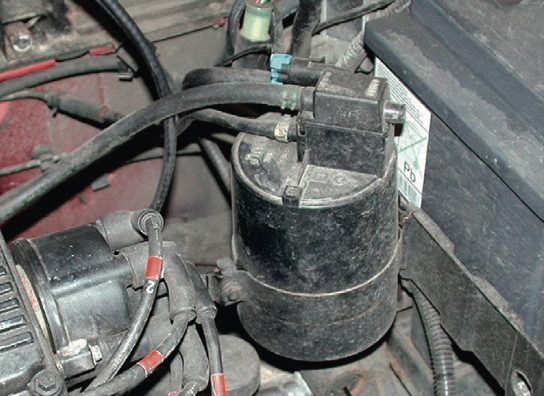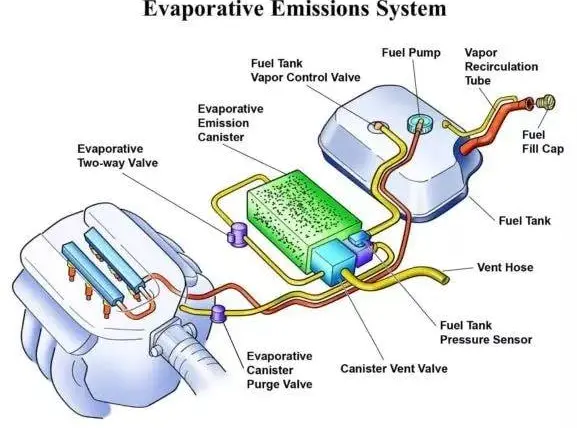The Evaporative Emission Control System (EVAP) is a crucial component in modern vehicles, designed to minimize the release of harmful emissions into the environment. The system works by capturing and storing fuel vapors that would otherwise escape into the atmosphere, and then recycling them back into the engine to be burned off. One of the most critical parts of the EVAP system is the canister, which serves as the primary storage unit for the fuel vapors. In this blog, we will discuss what the EVAP canister is, how it works, and its importance in reducing emissions.
What is an EVAP canister?
An EVAP canister is a small, plastic or metal container that is part of the vehicle’s EVAP system. The canister is designed to capture and store fuel vapors that are generated in the fuel tank and fuel system. The canister is typically located in the engine compartment or under the vehicle, and is connected to the fuel tank and the rest of the EVAP system via a network of hoses and valves.

How does an EVAP canister work?
The EVAP canister works by capturing fuel vapors that would otherwise escape into the atmosphere, and storing them in the canister. The canister contains activated carbon, which acts as a sponge to absorb and hold the fuel vapors. When the engine is running, the stored vapors are drawn back into the engine and burned off, preventing them from being released into the air.
The EVAP system works in a closed loop, with a series of sensors and valves that monitor and control the flow of fuel vapors. The canister is designed to capture vapors when the vehicle is not in use, such as when it is parked overnight. During this time, the EVAP system is in a “closed” state, meaning that the fuel tank is sealed off from the atmosphere. When the engine is running, the EVAP system switches to an “open” state, allowing fuel vapors to be drawn into the engine and burned off.
Why is the EVAP canister important?
The EVAP canister is an essential component of the EVAP system, as it plays a crucial role in reducing emissions. By capturing and recycling fuel vapors, the system prevents them from being released into the environment, where they can contribute to air pollution and climate change. In addition, the EVAP system can help to improve fuel efficiency, as it ensures that all of the fuel that is put into the tank is used for propulsion, rather than being wasted as vapor.
Conclusion
The EVAP canister is a critical component of modern vehicles, designed to capture and store fuel vapors that would otherwise escape into the environment. By recycling these vapors back into the engine, the EVAP system helps to reduce emissions and improve fuel efficiency. As vehicle emissions continue to be a significant contributor to air pollution and climate change, the EVAP system and canister will continue to play a vital role in reducing the impact of transportation on the environment.
Certainly! The EVAP canister is an essential part of the Evaporative Emission Control System (EVAP) in modern vehicles. The EVAP system is designed to capture fuel vapors that are generated in the fuel tank and fuel system, preventing them from escaping into the atmosphere. The EVAP canister serves as a storage unit for these fuel vapors until they can be drawn back into the engine and burned off.
The canister is typically made of plastic or metal and contains activated carbon. The activated carbon acts as a sponge to absorb and hold the fuel vapors, preventing them from escaping into the environment. The canister is connected to the fuel tank and the rest of the EVAP system via a network of hoses and valves.
When the engine is running, the EVAP system switches to an “open” state, allowing fuel vapors to be drawn back into the engine and burned off. This process is controlled by a series of sensors and valves that monitor and control the flow of fuel vapors. For example, if the system detects a leak, it will trigger a “check engine” light on the dashboard, alerting the driver to a potential problem.
The EVAP canister and system are essential in reducing emissions from vehicles. Fuel vapors are a significant source of air pollution and can contribute to climate change. By capturing and recycling these vapors, the EVAP system helps to reduce the impact of transportation on the environment. In addition, the EVAP system can improve fuel efficiency, as it ensures that all of the fuel that is put into the tank is used for propulsion, rather than being wasted as vapor.
It’s important to note that the EVAP system and canister are subject to wear and tear over time. The canister can become clogged with debris or damaged by corrosion, and the hoses and valves can develop leaks. Regular maintenance and inspection can help to keep the system functioning properly and prevent more significant problems down the line.
In conclusion, the EVAP canister is an essential component of the Evaporative Emission Control System in modern vehicles. By capturing and recycling fuel vapors, the system helps to reduce emissions and improve fuel efficiency. Regular maintenance and inspection can help to keep the system functioning properly and prevent problems down the line.
Advantages of the EVAP canister and system:
- Reduces emissions: The primary advantage of the EVAP canister and system is that it helps to reduce emissions from vehicles. By capturing fuel vapors that would otherwise escape into the atmosphere, the system helps to prevent air pollution and reduce the impact of transportation on the environment.
- Improves fuel efficiency: The EVAP system can also help to improve fuel efficiency, as it ensures that all of the fuel that is put into the tank is used for propulsion, rather than being wasted as vapor. This can help to save money on fuel costs over time.
- Helps meet emissions regulations: The EVAP system is required by law in many countries, including the United States, to meet emissions regulations. By using the system, vehicle manufacturers can ensure that their vehicles meet these regulations and avoid penalties.
Disadvantages of the EVAP canister and system:
- Requires maintenance: The EVAP system and canister require regular maintenance and inspection to ensure that they are functioning properly. Failure to maintain the system can result in leaks or other problems that can cause emissions to increase and potentially damage the vehicle.
- Can be expensive to repair: If the EVAP system or canister fails, it can be expensive to repair. The system is complex and requires specialized equipment to diagnose and fix, which can add to the cost of repairs.
- Can be a source of problems: In some cases, the EVAP system or canister can be a source of problems for vehicle owners. For example, if the system detects a leak, it can trigger a “check engine” light on the dashboard, which can be confusing or alarming for drivers.
In summary, the EVAP canister and system offer several advantages, including reducing emissions, improving fuel efficiency, and meeting emissions regulations. However, they also have some disadvantages, such as requiring regular maintenance, being expensive to repair, and potentially causing problems for vehicle owners. Overall, the benefits of the EVAP system outweigh the disadvantages, and it remains an essential component of modern vehicles.










